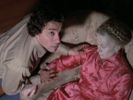Eye For Film >> Movies >> Don't Go In The House (1980) Film Review
Made during the onset of the slasher boom in the early Eighties, Joseph Ellison’s Don’t Go In The House exhibits many traits of the then burgeoning subgenre; namely gory effects, misogynistic violence, flashbacks revealing a prior trauma/instigating event, point-of-view stalking scenes and a sexually repressed killer driven insane by a monstrous matriarch.
The film sets itself apart from other slashers of its time by providing more insight into what makes the killer at the centre of its downbeat narrative tick. Donnie (Dan Grimaldi) works at an incinerator and after witnessing one of his co-workers catch fire, his already seemingly delicate mindset becomes completely unhinged when he returns home to find his mother dead.

Various flashbacks inform us of their grotesque relationship – she ruled the roost and frequently abused Donnie, burning his arms on a gas stove when he was ‘bad.’ Now alone in the world, Donnie exorcises his infernal demons by abducting young women, bringing them home to ‘meet’ his mother and burn them alive in a specially built room in his basement.
Despite the low budget, uneven performances and buckets of sleaze, Don’t Go In The House still wields the power to disturb, especially in several creepy and effectively realised scenes. The most gut-wrenching of these comes with the depiction of the first victim’s demise; naked and chained up, she is doused in petrol and blasted with a flame-thrower. The camera lingers long enough on this carnage to ensure it makes for deeply unsettling and uncomfortable viewing. Nasty stuff.
Perhaps surprisingly, there is slightly more to the plot than just a deranged madman in a flame-retardant suit burning up naked ladies. Attempts are made to explore Donnie’s psychological trauma, albeit in a sleazily exploitative way, and the film really hammers home its notions on the cyclical nature of abuse and the violence and misery it perpetuates.
The subjectivity of the narrative places us firmly in Donnie’s skewed mindset from the beginning and we follow events from his warped perspective as the motif of fire becomes an increasingly purifying force. The subjective nature of the story coupled with Dan Grimaldi’s fairly effective performance ensures that some sympathy is generated for the desperate and murderous loner.
The influence of Psycho is also overwhelmingly evident; Ellison’s flick features a mentally insecure young man dominated by an overbearing mother and whose obsession with her and her reign of terror drives him to murder. That her vice-like hold over him continues from beyond the grave, and his frequent conversations with her charred corpse which he keeps upstairs in their vast and creepy house perched atop a lonely hill, also evoke memories of Hitchcock’s classic chiller.
Suffering from disturbing visions and hearing voices which prompt him to take control and kill, it soon becomes clear that Donnie is an undiagnosed paranoid schizophrenic, and while this is only explored through exploitative means – mainly the depictions of his abuse-driven psychotic rampage - it is still an interesting and infrequent approach which further highlights the influence of Psycho.
Echoes Of Deranged (1974) and Maniac (1980) also resonate throughout Don’t, particularly in the revelation that Donnie’s hatred of women stems from his abusive mother and his attempts to take revenge on her by brutally murdering any woman who is unfortunate enough to cross his path. The shots of the incinerated remains of his victims sitting around in house-wear are extremely eerie.
Other startling imagery comes courtesy of an apocalyptic dream sequence on a beach where Donnie is pulled into an open grave by his cremated victims. Surreally nightmarish moments such as these, pierce through an otherwise dreary atmosphere. For every genuinely disturbing moment, however, there is an unintentionally humorous one, such as the scene where we see Donnie going clothes shopping for his date at the disco.
Possible salvation comes when the hand of friendship is extended to Donnie by a sympathetic workmate and a priest, who catches Donnie attempting to steal holy water from the font. The discussion between Donnie and the priest throws up some interesting ideas about faith, forgiveness, retribution and redemption, but Ellison’s screenplay doesn’t delve as deeply into these matters as the likes of say, Abel Ferrara, who often pontificated on such matters in equally exploitative narratives. The influence of the just-emerging slasher movie also weasels its way into the unnecessary ending in which a possible sequel is set up.
Don’t Go In The House will most likely appeal to fans of 'video nasties' and those seeking trashy, exploitative entertainment. That said, a number of the murder scenes are genuinely disturbing and the overall gritty, depressing atmosphere ensures proceedings are swathed in downbeat gloominess. As a depiction of one man’s downward spiral into insanity and chaos, Don’t Go In The House makes for frequently unsettling viewing.
Reviewed on: 08 Apr 2012



















